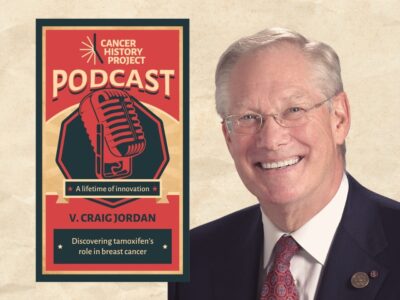V. Craig Jordan, a pharmacologist who discovered selective estrogen receptor modulators, died on June 9.
Jordan, a professor at The University of Texas MD Anderson Cancer Center who was credited with discovery of tamoxifen, was 76.
An obituary appears in this issue.
Jordan appeared on the Cancer History Project podcast in 2022 to discuss his life, career, and then-newly published memoir, “Tamoxifen Tales: Suggestions for Scientific Survival.”
“Before tamoxifen, postmenopausal women that were at least five years after the menopause, they’d been estrogen-starved,” Jordan said in the interview at that time. “They were treated with high-dose estrogen, and some of the tumors just melted away.”
When legendary pathologist Sir Alexander Haddow delivered the inaugural David Karnofsky Lecture in 1970, Jordan was conducting PhD research on nonsteroidal antiestrogens.
Jordan said:
So, Haddow, in his Karnofsky lecture said, “It’s really sad because nobody’s particularly interested in finding out why this happens. It’s a very important observation for a few patients, but it’s not enough to make a difference.”
So, when I won my Karnofsky Lecture years later, I basically dedicated it to Alexander Haddow, and said, “We figured it out. We know why that happens,” and he had in his paper all the requirements: they had to be five years after the menopause. If it was before the menopause, estrogen treatment for breast cancer didn’t work. So, they had to be estrogen-starved for a period of time.
Read the transcript and listen to the podcast on the Cancer History Project:


Craig Jordan on discovering tamoxifen’s role in breast cancer—and a lifetime of innovation
By Cancer History Project, Nov. 11, 2022
Shortly after Craig Jordan finished his PhD in the 1970s, he was invited by Michael Harper to work at the Worcester Foundation, the “home of the oral contraceptive.”
Jordan arrived only to find that Harper had left for Geneva, leaving the recent graduate on his own. “I don’t know anything!” Jordan, professor of breast medical oncology as well as molecular and cellular oncology at MD Anderson Cancer Center, said at the time.
Harper was the co-patent holder of ICI’s experimental drug 46,474, which had failed as an oral contraceptive.
So, Jordan decided to work with what he had.
“‘Why don’t we turn ICI 46,474 into a breast cancer drug?’ There’s been one publication on that and it shows it’s as good as estrogen,” Jordan, who is also a member of the U.S. National Academy of Sciences and the National Academy of Medicine and an honorary fellow of the Royal Society of Medicine, said.
ICI 46,474 would later come to become known as tamoxifen, and Jordan’s work would change the face of breast cancer prevention and treatment for the next 30 years.
Recently, Jordan published a scientific memoir, “Tamoxifen Tales: Suggestions for Scientific Survival” (The Cancer Letter, May 27, 2022).
Jordan’s early animal studies with tamoxifen showed promise, and his career gained speed as he presented these results around the country. Jordan’s animal studies also showed that cancer in rats was hormone-dependent.
“You could take the ovaries out, the tumors would regress, you could take the ovaries out, put the carcinogen in, then they wouldn’t get tumors, because you needed estrogen to do that,” he said.
“So, I did studies on prevention for the first time, and did the first presentations at international meetings on that. What if we could prevent breast cancer? They hadn’t invented prevention at that time. So, you’re talking to a brick wall,” Jordan said. “Prevent breast cancer? Oh God, here comes Craig Jordan talking about tamoxifen again. Pretend you haven’t seen him.”
Quote of the week
You can make discoveries when you’re not anticipating them, you’ve just got to keep awake during the experiment to be able to say, ‘Now I understand something strange is going on.’ Let’s just go back in history.
V. Craig Jordan


Craig Jordan’s “Tamoxifen Tales” chronicles a pathbreaking scientific career
By Donald L. “Skip” Trump, May 27, 2022
One would get little quarrel with the hypothesis that the development of “targeted therapy” is one of the most substantial advances in cancer care and cancer research over the past 50 years.
In fact, my colleague Eric Rosenthal and I recently conducted a poll, published in “Centers of the Cancer Universe,” of more than 100 cancer leaders and scientists, asking each what they judged to be the most important advances in cancer research since the signing of the National Cancer Act on Dec. 23, 1971.
Of the responses, 70% noted advances in immunology and the development of immune checkpoint inhibitors, 65% cited discoveries in genetics and genomics and the Human Genome Project, and 62% voted for the development of “targeted therapies” —the most frequently cited being receptor tyrosine kinase inhibitors (e.g., imatinib), monoclonal antibodies (e.g., trastuzumab).
Interestingly, tamoxifen was mentioned by only a few respondents. It is very easy to argue, however, that tamoxifen was one of the first targeted therapies, having been studied initially in the mid-1960s as a contraceptive; rather shortly after failing in that application was picked up and studied by a young British PhD student at Leeds University in the early 1970s, V. Craig Jordan.
Tamoxifen Tales: Suggestions for Scientific Survival (Excerpt)
By Cancer History Project, May 27, 2022
The forward of “Tamoxifen Tales: Suggestions for Scientific Survival,” as well as chapter 10, are made available by ScienceDirect.
This column features the latest posts to the Cancer History Project by our growing list of contributors.
The Cancer History Project is a free, web-based, collaborative resource intended to mark the 50th anniversary of the National Cancer Act and designed to continue in perpetuity. The objective is to assemble a robust collection of historical documents and make them freely available.
Access to the Cancer History Project is open to the public at CancerHistoryProject.com. You can also follow us on Twitter at @CancerHistProj, or follow our podcast.
Is your institution a contributor to the Cancer History Project? Eligible institutions include cancer centers, advocacy groups, professional societies, pharmaceutical companies, and key organizations in oncology.
To apply to become a contributor, please contact admin@cancerhistoryproject.com.









